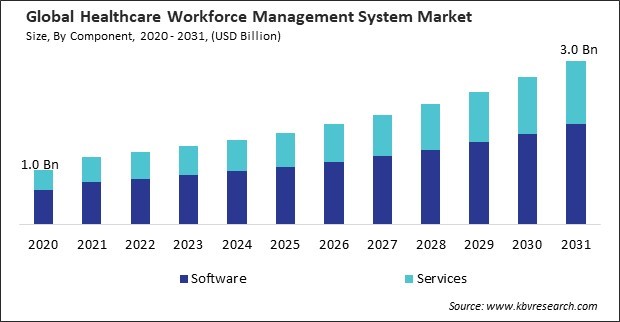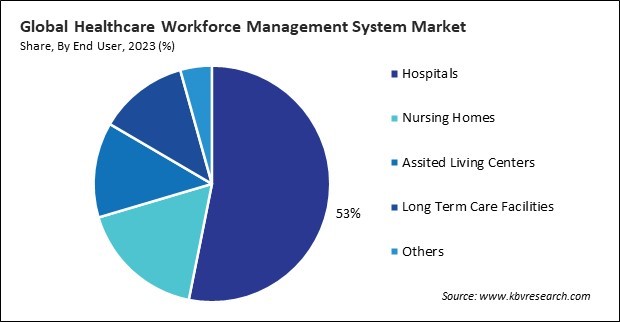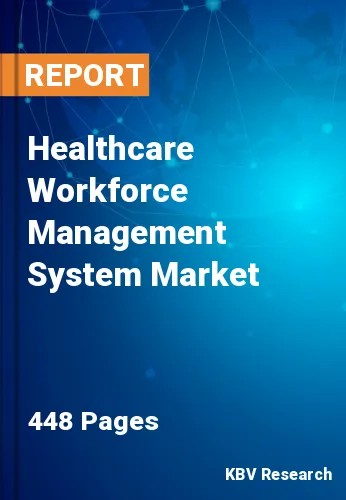“Global Healthcare Workforce Management System Market to reach a market value of USD 3.0 Billion by 2031 growing at a CAGR of 9.8%”
The Global Healthcare Workforce Management System Market size is expected to reach $3 billion by 2031, rising at a market growth of 9.8% CAGR during the forecast period.
The Asia Pacific region's rapidly growing and aging population increases the demand for healthcare services. As the number of patients rises, healthcare facilities need efficient workforce management to handle the expanding workload. The region faces significant healthcare workforce shortages and high turnover rates. Consequently, the Asia Pacific region would acquire nearly 30% of the total market share by 2031.

Healthcare professionals often face high levels of stress and burnout due to the demanding nature of their work. Healthcare organizations must comply with various regulatory requirements for staffing, working hours, and employee well-being. In conclusion, increasing focus on workforce well-being and retention drives the market's growth.
Additionally, With the rising demand for healthcare services, there is a need for more healthcare professionals to manage the larger number of patients. As demand for healthcare services rises, managing workforce shortages becomes critical. Workforce management tools help healthcare organizations identify and address gaps in staffing quickly. Thus, increasing demand for healthcare services is propelling the market's growth.
However, the upfront cost of purchasing or licensing advanced workforce management software can be substantial. This includes not only the cost of the software itself but also any necessary hardware. In addition, ongoing technical support and maintenance are necessary to address any issues with the system. Therefore, high implementation and maintenance costs are impeding the market's growth.
Moreover, Training programs for new workforce management systems were disrupted or delayed, impacting staff readiness and adaptation to new technologies. The focus on immediate pandemic response limited the resources available for ongoing workforce development and training initiatives. Integrating new workforce management technologies with existing systems faced delays due to the focus on managing pandemic-related challenges and changes. Thus, the COVID-19 pandemic had a negative impact on the market.
Based on component, the market is divided into software and services. In 2023, the services segment held 37% revenue share in the market. Implementing and integrating workforce management software can be complex. Services such as consulting, implementation, and integration ensure that these systems are set up correctly and tailored to the specific needs of healthcare organizations, leading to smoother transitions and better system performance.
By end user, the market is divided into hospitals, nursing homes, assisted living centers, long-term care facilities, and others. The nursing homes segment held 17% revenue share in the market in 2023. Managing labor costs is crucial for nursing homes, especially given many facilities' tight budgets. Workforce management systems provide tools for budgeting, forecasting, and controlling labor costs.

Based on organization size, the market is categorized into large, medium, and small. The medium segment witnessed 30% revenue share in the market in 2023. As medium-sized healthcare organizations expand, they face increased complexity in managing staff schedules, payroll, and compliance. Workforce management solutions help streamline these processes.
On the basis of deployment, the market is segmented into on-premises model, cloud-based model, and SaaS- based/web-based model. In 2023, the cloud-based model segment attained 32% revenue share in the market. Cloud-based solutions offer scalable infrastructure that can easily grow with the organization’s needs.
Free Valuable Insights: Global Healthcare Workforce Management System Market size to reach USD 3.0 Billion by 2031
Region-wise, the market is analyzed across North America, Europe, Asia Pacific, and LAMEA. The North America region witnessed 37% revenue share in the market in 2023. North America, especially the United States and Canada, has highly developed healthcare systems with complex organizational structures. This complexity necessitates sophisticated workforce management solutions to ensure effective staffing and compliance.
| Report Attribute | Details |
|---|---|
| Market size value in 2023 | USD 1.4 Billion |
| Market size forecast in 2031 | USD 3.0 Billion |
| Base Year | 2023 |
| Historical Period | 2020 to 2022 |
| Forecast Period | 2024 to 2031 |
| Revenue Growth Rate | CAGR of 9.8% from 2024 to 2031 |
| Number of Pages | 448 |
| Number of Tables | 750 |
| Report coverage | Market Trends, Revenue Estimation and Forecast, Segmentation Analysis, Regional and Country Breakdown, Porter’s 5 Forces Analysis, Company Profiling, Companies Strategic Developments, SWOT Analysis, Winning Imperatives |
| Segments covered | Component, Deployment, End User, Organization Size, Region |
| Country scope |
|
| Companies Included | Oracle Corporation, SAP SE, ATOSS Software SE, Infor, Inc. (Koch Industries), UKG, Inc., Workday, Inc., WorkForce Software, LLC, Paycor Hcm, Inc, Rippling People Center Inc. and symplr |
By Component
By End User
By Organization Size
By Deployment
By Geography
This Market size is expected to reach $3 billion by 2031.
Increasing focus on workforce well-being and retention are driving the Market in coming years, however, High implementation and maintenance costs restraints the growth of the Market.
Oracle Corporation, SAP SE, ATOSS Software SE, Infor, Inc. (Koch Industries), UKG, Inc., Workday, Inc., WorkForce Software, LLC, Paycor Hcm, Inc, Rippling People Center Inc. and symplr
The expected CAGR of this Market is 9.8% from 2024 to 2031.
The Software segment generated the highest revenue in the Market by Component in 2023; thereby, achieving a market value of $1.8 billion by 2031.
The North America region dominated the Market by Region in 2023, and would continue to be a dominant market till 2031; thereby, achieving a market value of $1.07 billion by 2031.
Our team of dedicated experts can provide you with attractive expansion opportunities for your business.

 Drivers
Drivers
 Restraints
Restraints
 Opportunities
Opportunities
 Challenges
Challenges
